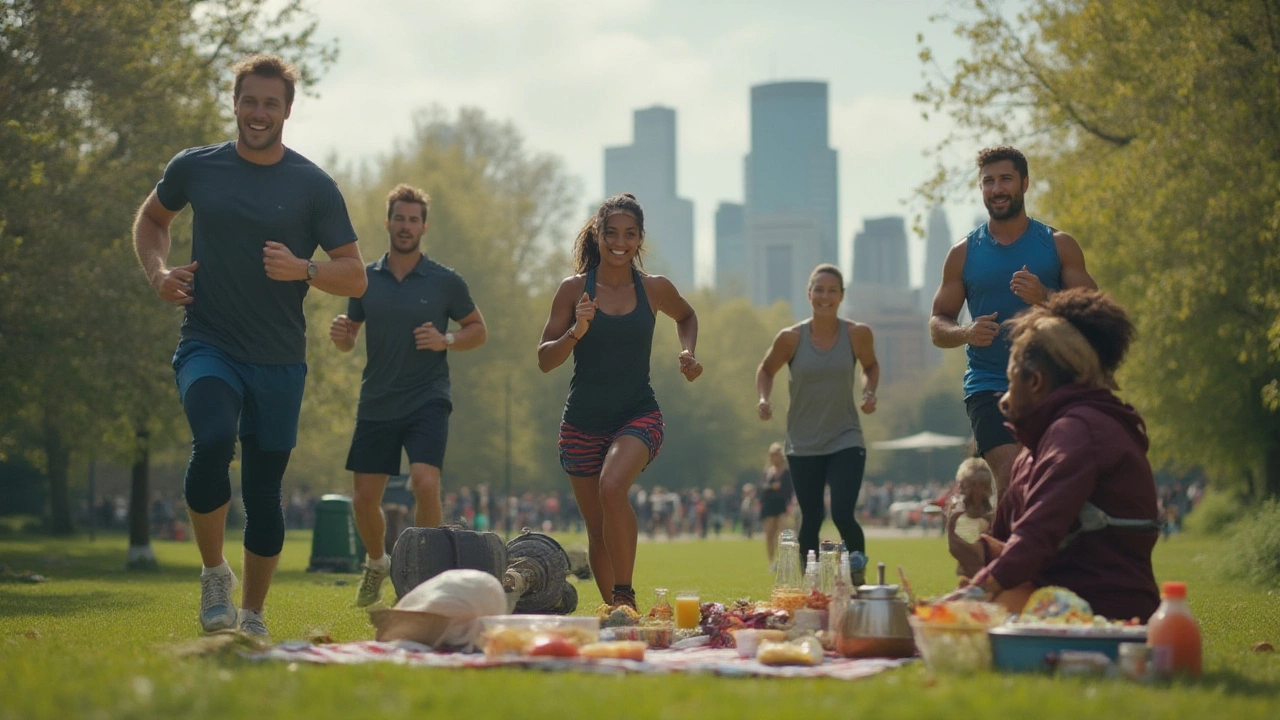Can You Get Ripped in 2 Months? Fat to Fit Fast Explained
 Jul, 13 2025
Jul, 13 2025
Your timeline: 60 days. The goal: go from soft to shredded with abs you can count. Extreme? Sure. But here’s the kicker: every summer, there’s always a surge in people looking to do exactly this, hoping for a “miracle body” before a big event. Viral before-and-after photos flood social media, all promising it’s possible if you just work hard enough. So, is it actually possible to get fat to ripped in two months? Or is this another internet pipe dream?
The Truth About Fast Transformations
Internet fitness challenges love the idea of shocking the body into shape overnight. You’ll see “12-week transformation” headlines all the time, but shaving that down to just 8 weeks? Even pro athletes with trainers and chefs struggle with big changes in that short a window. Here’s why: the human body is pretty stubborn. To see a truly ripped physique, like sub-10% body fat with visible abs, you have to build muscle and drop fat—two things that fight each other for your energy.
Let’s take a look at some hard math. A single pound of fat clocks in at about 3,500 calories. So, to drop 20 pounds, you’d need to burn off roughly 70,000 calories—more than most people burn in 3 weeks. Now, the CDC suggests that 1-2 pounds of fat loss per week is safe and realistic. That puts you at maybe 16 pounds lost in 2 months for most, if you’re really hustling. That isn’t nothing, but it’s rarely “movie ripped.”
Think about your muscle: building it is a slow grind. You might be able to gain 2 to 4 pounds of muscle in a couple months if you’re new to strength training — and that’s best-case scenario. Add in factors like sleep, genetics, and stress, and those numbers can shrink even more. Shred fast, and you risk losing muscle along with the fat — leaving you looking deflated, not defined.
Sure, some transformations are dramatic. But a ton of “miracle” photos are staged. Lighting, posing, dehydration, even Photoshop play their part. Fitness model Greg O’Gallagher famously revealed how he faked his own before-and-after using salt, carbs, and clever camera tricks—all in the same day.
If you’re carrying a bit of fluff and want to drop a few inches, two months can be enough to see actual changes in the mirror. If you’re expecting an underwear-model look, that’s not realistic for most bodies—at least not safely. But can you make a jaw-dropping difference? With discipline and the right plan, you’ll surprise yourself.
Body Fat, Muscle, and Metabolism: What You Need to Know
Let’s get into the mechanics. Your body wants to hold onto fat, especially around the belly. That’s an evolutionary thing—it never knows when the next famine might hit. When you start eating less and moving more, your metabolism adjusts by slowing down, making it even harder to continue losing weight at the same rate. That’s why “crash diets” often backfire. You start strong, but after a week or two, the weight loss stalls.
Quick fact: Muscle is like your body’s engine. The more you have, the more calories you burn at rest. Someone with a lot of muscle burns way more on the couch than a similar-sized person with less muscle. That’s why strength training should be at the core of any fast transformation plan. Skip it, and you’ll lose muscle along with fat, making it way harder to look defined.
Here’s something most people overlook: water retention. If you suddenly start eating cleaner and working out, you’ll lose some water weight up front. That first five pounds? It’s mostly water, not fat. That’s motivating, but it won’t last. After the first week or two, the real work begins.
Your hormones matter, too. Dietary changes can throw everything off, especially if you’re cutting calories too aggressively. Guys are at risk for low testosterone, which can zap your muscle gains and make you tired. Women can mess up their cycles, and both sexes can feel irritable, hungry, and foggy-headed.
The genetics card is real as well. Some people store fat in their bellies, others in their hips. Some can drop weight quickly; others swear their bodies just hold on out of spite. Comparison just leads to discouragement—focus on your own pace and progress.
Here’s a quick chart showing the relationship between body fat percentage, visual definition, and typical time required for a visible transformation, assuming solid nutrition and training:
| Starting Body Fat (%) | Visual Change (2 months) | Achievable End Point |
|---|---|---|
| 25-30 | Noticeable loss, more energy, looser clothes | 18-20% (some definition, not ripped) |
| 18-25 | Bigger fat loss, some muscle showing | 12-15% (abs peeking through, athletic) |
| 12-18 | Lean look, abs visible with good lighting | 10-12% (ripped, almost model status) |
So yeah, addressing body fat percentage is probably the best bang for your buck. You won’t gain a ton of muscle in two months, but you can absolutely look like you did just by getting leaner.

Diet: Your Fastest Lever for Change
If you want rapid results, your fork is going to matter more than any dumbbell. Most people underestimate how much they actually eat during the day. One donut here, a couple handfuls of chips there—it all adds up. The key isn’t to starve yourself but to create a steady calorie deficit without tanking your energy or getting cranky.
Start by tracking everything you eat for three days. Use your phone, an app, or old-school pen and paper. You’ll probably be shocked at the hidden calories. Cut out liquid calories first—sodas, juices, fancy coffee drinks. Just switching to water can save hundreds of calories a day.
Next, focus on protein. Study after study shows that high-protein diets help people lose more fat and keep muscle. That means chicken, lean beef, fish, tofu, eggs, and Greek yogurt. Aim for at least 1 gram per pound of body weight. That’s ambitious but totally doable for two months. Fill out your meals with veggies and some healthy fats—avocado, nuts, olive oil.
Carbs aren’t the enemy, but you want to use them strategically. Eat them right around your workouts, when your muscles actually need the fuel. Oats, potatoes, rice, and fruit all work, but watch the portions. Save the Saturday night pizzas for after your transformation window.
Don’t forget about fiber. High-fiber carbs keep you full and keep things moving. Some studies show that people trying to get lean often struggle with digestion if they suddenly ramp up protein but ignore fiber.
Meal prep is your new best friend. If there’s food at home, you control the ingredients. If you’re always grabbing takeout or fast food, you’re playing with fire. Spend a couple hours on Sunday cooking chicken, chopping veggies, and portioning out meals for the week.
Cheat days? Skip them for these 2 months. If you really need a treat, work it into your overall calories. But consistency always beats perfection. Missing your macros once won’t wreck you, but making it a habit will.
Want a science-backed hack? Try intermittent fasting. Several studies in the past few years have shown that people who skip breakfast and eat within an 8-hour window can lose more body fat, even with the same number of calories. It helps with appetite control too. Just make sure you’re still getting enough protein and nutrients during your eating window.
Training: The Smart Way to Get Ripped Fast
You can’t out-run a bad diet, but you can speed things up with the right training plan. The goal isn’t to spend hours on the treadmill; it’s to build muscle and burn as many calories in as little time as possible.
First, lift heavy things, three to five times a week. Compound moves—like squats, deadlifts, bench presses, and pull-ups—hit the biggest muscle groups and torch the most calories. If you’re new, focus on perfect form, not ego-lifting. Muscle is built with progressive overload—consistently adding weight or reps so your body adapts.
HIIT (High-Intensity Interval Training) is your secret weapon. Just 20 minutes of sprints or circuit training can burn more calories than an hour of steady jogging, and the afterburn effect keeps your metabolism cranked for hours. Think short bursts of all-out effort, followed by quick rests. Swap in burpees, sprints, kettlebell swings, or jump rope.
Classic cardio still works, but keep it contained. Two or three shorter sessions a week will help, but don’t overdo it—endless running can chew through muscle if you’re dieting hard. Mix up the intensity. For example, try this weekly setup:
- Day 1: Full-body weights + 15-min HIIT
- Day 2: Steady-state cardio (brisk walk or bike)
- Day 3: Upper body weights + core
- Day 4: Rest or easy stretching
- Day 5: Lower body weights + HIIT
- Day 6: Cardio (intervals or hills) + core
- Day 7: Rest or gentle yoga
Don’t sleep on the power of steps. Non-exercise activity—walking the dog, pacing during phone calls, taking stairs—adds up. Set a target of 8,000-12,000 steps a day. The people who get super lean treat every step like it counts, because it does.
Next, track everything. Keep a workout log—reps, sets, and weights—or use a fitness app. Seeing progress, even slight, keeps your motivation high when the mirror is slow to change.
Finally, don’t ignore recovery. Muscle grows when you rest, not when you’re working out. Prioritize 7 to 9 hours of sleep and add in active recovery—stretching, foam rolling, or light yoga.

Mindset: The Hidden Power Behind Fast Results
All the meal plans and workout charts mean nothing if your head isn’t in the game. Transforming your body is tough—physically and mentally. You’ll probably deal with cravings, self-doubt, and days where you want to bail. Most people quit in the first two weeks because the effort feels way out of proportion to the results.
The trick? Find your real “why.” Maybe it’s fitting into your favorite jeans, or proving a point to yourself. Write it down and stick it somewhere you’ll see it every day. The physical transformation can be dramatic, but the mental one—building grit and discipline—lasts a lot longer.
Habits beat willpower every time. Build a routine. Set times for meals, workouts, and even sleep. The fewer decisions you have to make, the easier it gets. If you plan your workouts in advance and lay out your gym gear, it’s one less excuse when you’re tired after work.
Mistakes will happen. There will be bad days. The key is not letting one slip-up turn into a week-long binge. Accept the bump, dust off, and get back to it.
Find some accountability. Tell a friend, hire a coach, or post your goals on social media. If other people know about your journey, you’re way less likely to ditch it at the first sign of struggle.
Be patient with your reflection. Physical changes move slower than Instagram highlights would have you believe. Snap progress pics every week in the same light and don’t obsess over tiny daily changes—you won’t spot them. But in eight weeks, you’ll barely recognize the face in the mirror if you’ve given it everything.
Stack small wins. Celebrate a new squat PR, a tighter belt loop, or making it through a sugar craving without caving. Break your main goal into tiny, bite-sized chunks—hit them one at a time.
And here’s the final mind-bender: most people who make fast transformations realize that the journey is addictive. Once you see what your body can do in two months, you’ll want to see what it can do in six or twelve.